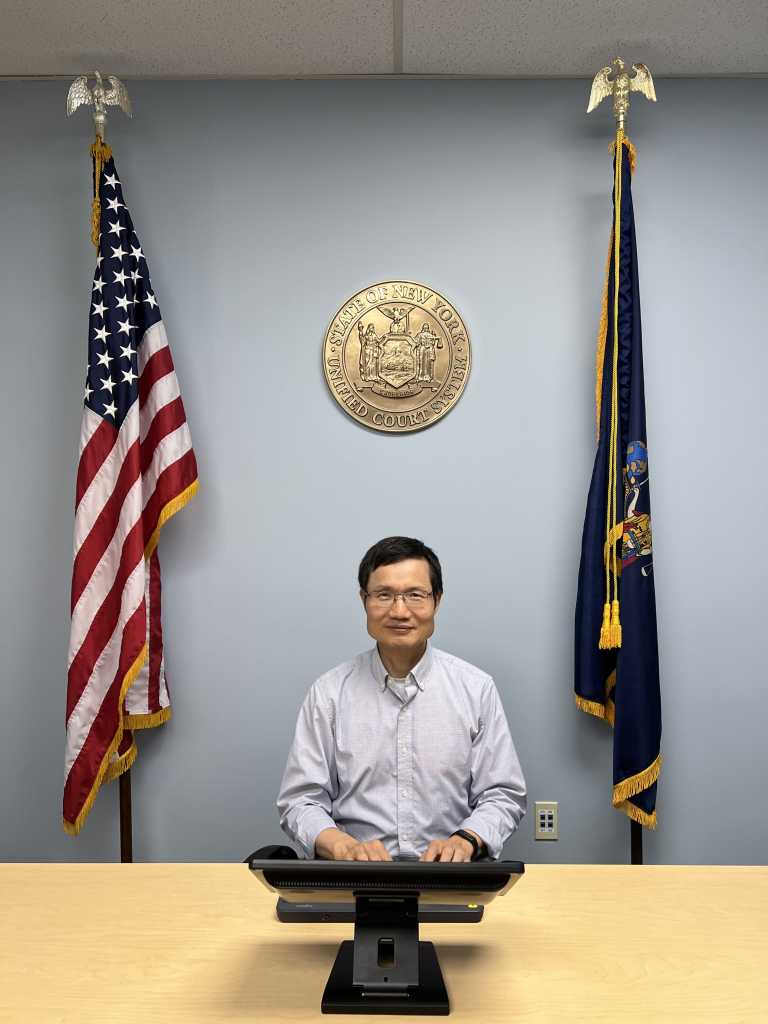- I tested a Pixel Tablet without any Google apps, and it's more private than even my iPad
- My search for the best MacBook docking station is over. This one can power it all
- This $500 Motorola proves you don't need to spend more on flagship phones
- Finally, budget wireless earbuds that I wouldn't mind putting my AirPods away for
- I replaced my Linux system with this $200 Windows mini PC - and it left me impressed
CIO 100 US: 9 award-winning government IT projects

Government entities around the globe are contending with the same demands and opportunities facing private-sector organizations. Public-sector agencies and institutions report increasing demand from constituents, employees, and their partners for more digital services, faster responses, and seamless experiences.
And, like their commercial counterparts, government IT leaders are boosting their use of technology to deliver.
For example, according to a 2022 report from Forrester Research, 10% of government administration workload will be automated, largely through use of robotic process automation (RPA) to eliminate repetitive, low-value tasks. Forrester also predicts that more government entities will adopt the zero-trust model to secure their growing number of digital services.
“There are parts of some [government] organizations that are humming like a top,” says Bobby Cameron, vice president and principal analyst at Forrester, citing NASA and the National Oceanic and Atmospheric Administration (NOAA) as two US federal government entities that are particularly advanced in their digital transformations. He also points to transportation and water departments, which have been heavy adopters of internet of things (IoT) technologies, as other digital leaders.
Cameron notes, however, that government as a whole is further behind other verticals in their digital journeys due to multiple factors, including funding mechanisms that favor cost-cutting initiatives instead of projects with focus on modern metrics around value effectiveness and customer obsession.
Still, transformation is happening at the local, state, and federal levels. In fact, such work is driving increased spending in government IT, as research firm Gartner predicts worldwide government IT spending will total $565.7 billion in 2022, up 5% from 2021 figures.
The CIO 100 Awards for IT Innovation and Leadership this year recognize nine projects that stand out as leading examples of the digital work under way within government. Here is a brief look at those efforts, as well as the impact they are having in streamlining processes, facilitating scale and innovation, and improving the lives of their constituents.
Bureau of IRM accelerates US drawdown from Afghanistan
Organization: Bureau of Information Resource Management, Department of State
Project: Afghanistan Drawdown and Humanitarian Response — Rapid Technology Enablement
IT leader: Keith A. Jones, CIO (Jones has since departed the State Department)
The Bureau of Information Resource Management (IRM) at the US State Department had a monumental task: Deliver immediate, previously unplanned technology and digital services without relying on the standard capital planning and resourcing approaches.
Moreover, it had to do that while working with COVID-related restrictions.
The stakes were high, as the work supported the drawdown of military forces in Afghanistan and the corresponding humanitarian needs.
The IRM faced several challenges in meeting this objective, the most acute was the speed of needed delivery, which required IRM to work without the guidance of established planning and execution processes. Other challenges included the need to work across multiple government entities and partner organizations on a 24/7 schedule; the emergence of unforeseen circumstances in a volatile situation; and the expectation to simultaneously address multiple significant demands for technology services and support.
In response, IRM brought together stakeholders from multiple government and nongovernmental entities to rapidly determine, develop, and deliver tech resources. It fostered secure collaboration methods among those stakeholders, many of whom were working remotely due to the pandemic and simultaneously were facing a high number of cybersecurity threats.
IRM’s efforts yielded major successes: delivering a multi-agency application to support issuing and tracking special-issue visas and related services; facilitating the complete shutdown of all Foreign Affairs agency networks in Afghanistan; rapidly transforming more than 100,000 workstations into softphone-enabled work locations; deploying multiple new applications, enhancements and reconfigurations; and supporting ongoing tech services.
Santa Monica facilitates data sharing to help homeless individuals
Joseph Cevetello, CIO, City of Santa Monica
City of Santa Monica
Organization: City of Santa Monica
Project: Project Connect
IT leader: Joseph Cevetello, CIO
Despite its history of allocating significant resources to support homeless individuals, Santa Monica, Calif., officials recognized that they lacked real-time awareness of the care provided to any one individual. The reason: City departments held data in siloes, thereby preventing them from gaining a comprehensive understanding of the services they collectively provided.
City officials believed that the ability to see end-to-end engagement with homeless individuals would lead to better understanding of outcomes, saving the city time and money while better helping individuals by providing more complete information at the point of contact.
To gain that visibility, the city’s IS department collaborated with Akido Labs as well as police, fire, human services, the city manager office, and the city’s legal team to develop Connect, a mobile app and data-sharing platform for first responders working with homeless individuals.
The project team emphasized customer empathy and used human-centered design processes to tailor the app to the unique needs of its city workers. It gathered data to identify and address barriers, verifying its findings with study participants through customer journey mapping. It also piloted the app with 100 homeless individuals, allowing the team to build trust in the product before a full-scale rollout.
Now fully deployed, the Connect app has delivered to first-responders greater insights, has led to better outcomes for homeless individuals, and has reduced city costs. “Since the introduction of Connect, encounters with police and emergency services have decreased by 33% and arrests of unhoused citizens are down by 37%,” notes City of Santa Monica CIO Joseph Cevetello.
Ginnie Mae modernizes on the cloud

Barbara Cooper-Jones, SVP, Office of Enterprise Data and Technology Solutions, Ginnie Mae
Ginnie Mae
Organization: Ginnie Mae
Project: Cloud Application Migration and Operations (CAMO)
IT leader: Barbara Cooper-Jones, SVP, Office of Enterprise Data and Technology Solutions
“Ginnie Mae wants to be a market leader in the mortgage backed-security industry,” says Barbara Cooper-Jones, CIO and senior vice president of the Office of Enterprise Data and Technology Solutions at Ginnie Mae. “We want to be an agile organization that responds to market changes quickly leveraging the best of breed and leading-edge technologies and sophistication. We need an agile, modernized, transformed scalable and efficient infrastructure to support our business and we want to provide a seamless user experience to our program participants.”
To deliver that, Ginnie Mae has embraced the cloud, recognizing it as a way to support business and technology modernization and transformation while also providing improved security, digital interoperability, advanced analytics, and other hyperautomation capabilities.
The organization’s goal is to operate 100% in the cloud and to rethink its infrastructure operations to ensure Ginnie Mae can better adapt to industry changes and provide the modern, scalable technology services necessary to fulfill its mission.
The resulting Cloud Application Migration and Operations (CAMO) project involved three major objectives: to migrate and consolidate all business operations onto a single cloud platform in AWS; to revamp infrastructure operations and stand up new capabilities in the cloud; and to establish governance and innovation foundations to enable the next generation of modernization and transformation initiatives.
Ginnie Mae is seeing numerous benefits from this project. The migration has enabled IT to deliver improved application performance and service. It has reduced costs and created more operational transparency. And it has created a more responsive organization.
King County secures and streamlines property tax exemption process

David Mendel, CIO, King County
King County
Organization: King County, Wash.
Project: Cutting-Edge AI Protects PII, Cuts Application Processing Time in Half
IT leader: Tanya Hannah, CIO (Hannah has since left the King County CIO post)
When King County, Wash., launched its online Senior Property Tax Exemption application in 2019, it gave seniors and disabled individuals the ability to electronically share photos of the documents required to show proof of eligibility for the program.
For seniors, the online process was a win, as it transformed a slow paper-based process into a convenient digital one. But those photos typically contained sensitive personal identifiable information (PII), so county workers spent on average 30 minutes per application manually redacting that PII and another 30 minutes assessing the actual application to determine eligibility.
With the county receiving more than 8,000 applications annually, the process became a drain on resources and delayed tax relief benefits to eligible residents. The IT team turned to intelligent technologies to address those issues.
Hannah and her team used computer vision and trained machine learning models to correctly identify the type of document submitted. They also used optical character recognition (OCR) technology to locate areas in the document that could contain PII and automatically redact it.
The IT team used a low-code approach with cognitive services on AWS (Rekognition computer vision, Textract OCR technologies, and A2I Amazon augmented intelligence) to accelerate delivery while still meeting the needed functionality and accuracy. The project cut application processing time in half while preserving PII privacy and security and the streamlined customer experience.
“The AI bots significantly reduce workload for King County employees, without sacrificing the user-friendly customer experience that enables approximately 8,000 low-income seniors to easily apply for tax relief each year. This innovative use of technology is helping us connect with underserved communities and grow equity,” says current King County CIO David Mendel.
Los Angeles County turns to BI and text alerts to address food insecurity

Michael Sylvester, assistant director and CIO, Los Angeles County Department of Public Social Services
Los Angeles County Department of Public Social Services
Organization: Los Angeles County Department of Public Social Services
Project: Outbound Text Campaign for Food Giveaways
IT leader: Michael Sylvester, assistant director and CIO
Figures from the Los Angeles Regional Food Bank showed that 1 in 5 LA County residents faced food insecurity prior to the COVID-19 pandemic, so officials braced for a spike in need when the pandemic hit and caused an economic shutdown.
The Los Angeles County Department of Public Social Services (DPSS) sought to address that elevated need for food through additional food distribution. At the same time DPSS recognized the need to effectively and efficiently alert residents about distribution locations and times. Its Outbound Text Campaign for Food Giveaways addressed that need.
“The project echoes the true spirit of the DPSS, which is to provide effective and caring service, even during the most trying circumstances,” says DPSS Assistant Director and CIO Michael Sylvester.
DPSS developed its own business intelligence solution to identify message recipients and used existing text messaging software (Acqueon), pairing it with AT&T’s Global Messaging service to deliver information in English and Spanish about food distribution to LA County residents.
DPSS identified eligible recipients using data housed in its own systems and sent texts throughout the program to those customers’ phone numbers using an automated text campaign technology. The platform for the text campaigns was established in approximately two weeks. DPSS performed 115 text campaigns from June 2020 to September 2021, resulting in nearly 3 million text messages successfully delivered to LA County residents.
MHBE expedites healthcare enrollment with AI, RPA

Venkat Koshanam, CIO, Maryland Health Benefit Exchange
Maryland Health Benefit Exchange
Organization: Maryland Health Benefit Exchange
Project: Automated Verification of Consumer Documents using AI, RPA, and OCR Technologies
IT leader: Venkat Koshanam, CIO
The Maryland Health Benefit Exchange’s core business process is enrolling Maryland state residents in health insurance programs such as Medicaid and the Qualified Health Plan, a process that involves verifying each enrollee’s identity, residency, and income status.
But there was a significant bottleneck in that process: Officials had to manually verify consumer identity and income when the federal and state data sources couldn’t match the information provided by consumers. Although vital, the manual process was time-consuming, error-prone, and expensive, and it delayed consumers from receiving health coverage.
To alleviate that bottleneck, MHBE designed a solution using multiple digital technologies, including artificial intelligence, machine learning, optical character recognition (OCR), and robotic process automation (RPA), to verify the consumer-provided documentations with minimal human intervention.
This automation has delivered benefits, with the number of days consumers had to wait when seeking coverage dropping from four to one. It also eliminated costly, mundane, repetitive manual tasks.
“It is vital that government agencies continuously implement innovative technology solutions that can deliver timely citizen benefits, eliminating error-prone legacy manual processes,” says CIO Venkat R. Koshanam. “MHBE utilizes conversational AI to engage with consumers, facilitates machine-reading of consumer documents through OCR technologies, and automates decision-making capabilities through RPA technologies to proactively render critical, timely health insurance benefits to Marylanders.”
Given its success with this project, MHBE plans to extend its technology solution to more document types and automate more documentation-verification tasks.
New York State Courts facilitates hybrid jury trials

Sheng Guo, program manager for courtroom modernization, New York State Courts
New York State Courts
Organization: New York State Courts
Project: From Virtual to Hybrid: A Transformation of Courtrooms for Jury Trials
IT leader: Sheng Guo, program manager for courtroom modernization
The New York State Unified Court System saw COVID-related restrictions impact its ability to fulfill its mission to deliver equal justice under the law and to achieve the just, fair, and timely resolution of all matters before the courts.
Courts could conduct some matters, such as hearings, in virtual mode; but jury trials were put on hold in 2020 due to the challenges of meeting social distancing requirements. So the court system tasked its Courtroom Modernization Initiative team with finding a solution.
In response, the CMI team developed, refined, and rapidly deployed technologies that enable jury trials to be conducted while still adhering to COVID-related restrictions. It delivered the technical components that enable hybrid trials, with some stakeholders physically in the courtroom and some parties appearing virtually.
The CMI team customized solutions based on courtroom conditions and the equipment available at the time. It deployed numerous technical remedies, including 500 mobile videoconferencing systems; audio mixers with additional microphones and speakers to improve the sound conditions in the courtrooms; assistive listening devices; and an easy-to-use courtroom streaming platform.
“The project to transform courtrooms for jury trials in a hybrid environment has had far-reaching impacts on the delivery of justice,” says Sheng Guo, program manager for courtroom modernization. “I can provide numerous examples of how this project has helped to uphold the constitutional right to jury trials and to instill the public trust in our judicial system.”
Statistics confirm that observation: The state’s jury trial capacity increasing from 26 in March 2021 to nearly 300 in December 2021.
National Museum of African American History goes virtual

Adam Martin, chief digital officer, National Museum of African American History and Culture, Smithsonian Institution
NMAAHC, Smithsonian Institution
Organization: National Museum of African American History and Culture, Smithsonian Institution
Project: Searchable Museum: First Digital Platform Dedicated to the African American Story
IT leader: Adam Martin, chief digital officer
The National Museum of African American History and Culture has had millions of visitors to its Washington, D.C., space but it wanted to broaden its reach, increase access to its holdings, and offer more education. So it decided to transform its traditional in-person exhibits to virtual experiences, a move that the museum believed was critical as interest in and demand for information about the African American experience increased.
The result: its Searchable Museum for the National Museum of African American History and Culture.
“From the beginning, we challenged ourselves to follow a more audience-centered, data-informed approach to its design and development,” the National Museum of African American History and Culture Chief Digital Officer Adam Martin says. “Together with our partners, the museum engaged in an iterative process to reimagine and transform the in-person visitor experience for online audiences.”
Working with digital services firm Fearless, the museum used human-centered design to develop a site that works on any device, at any bandwidth, and within the Web Content Accessibility Guidelines (WCAG) to meet the needs of any user in any location. It used the agile development methodology and its iterative process to continually enhance the site ahead of its launch.
Today site users can pull in exclusive objects and show fully digitized models. They can also interact with artifacts in ways that they can’t in person, such as rotating an object or virtually walking inside a wooden cabin once inhabited by enslaved individuals. Museum officials say these capabilities help create a more powerful connection to history for users.
USPTO accelerates patent applications with AI

Jamie Holcombe, CIO, USPTO
USPTO
Organization: USPTO
Project: USPTO Patent Auto-Classification with AI and ML
IT leader: Jamie Holcombe, CIO
The US Patent and Trademark Office receives some 2,000 applications per day, and the office processes more than 600,000 applications each year.
Once received, USPTO must categorize applications according to the technical features of their content, with applications assigned classification codes based on a hierarchical list of 250,000-plus terms indicating the subject matter of the invention.
Doing this work manually is a time-consuming task that adds up to more than $20 million in costs per year. Moreover, like any other manual process, this one is prone to errors that can slow the pace of application review and approval.
The USPTO turned to automation, artificial intelligence, and machine learning to improve that classification process. Having embraced a product approach for managing IT, the technology team adopted a customer-focused development mindset and collaborated with business teams to understand how examiners classified applications.
This work enabled IT to develop a multi-label classification model predicting classification symbols. Additionally, the collaborative approach allowed the teams to identify the high-quality, trustworthy data needed to train the AI/ML models powering the new classification tool.
The IT team delivered the new auto-classification tool in just 90 days, with benefits yielding enough returns to recoup development costs within the first few months of deployment.
“In this endeavor we developed an auto-classification tool that leverages ML to classify patent documents for efficiency and impact. The classification information is shared globally, provided to our search tools, and affects how work gets assigned to our examiners. Scaling our efforts not only drives efficiency but helps the US’s global leadership position in intellectual property,” says USPTO CIO Jamie Holcombe.

